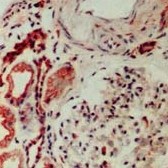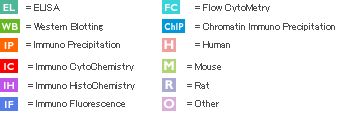| Reference |
- J Biol Chem. 1991 Apr 25;266(12):7329-32.
Immunochemical approach to characterize advanced glycation end products of the Maillard reaction. Evidence for the presence of a common structure.
Horiuchi S, Araki N, Morino Y.
- Am J Pathol. 1995 Sep;147(3):654-67.
Immunohistochemical and ultrastructural detection of advanced glycation end products in atherosclerotic lesions of human aorta with a novel specific monoclonal antibody.
Kume S, Takeya M, Mori T, Araki N, Suzuki H, Horiuchi S, Kodama T, Miyauchi Y, Takahashi K.
- Biochemistry. 1996 Jun 18;35(24):8075-83.
N (epsilon)-(carboxymethyl)lysine protein adduct is a major immunological epitope in proteins modified with advanced glycation end products of the Maillard reaction.
Ikeda K, Higashi T, Sano H, Jinnouchi Y, Yoshida M, Araki T, Ueda S, Horiuchi S.
- J Invest Dermatol. 1997 May;108(5):797-802.
Photo-enhanced modification of human skin elastin in actinic elastosis by N(epsilon)-(carboxymethyl)lysine, one of the glycoxidation products of the Maillard reaction.
Mizutari K, Ono T, Ikeda K, Kayashima K, Horiuchi S.
- J Clin Pathol. 1998 Jul;51(7):515-9.
Immunohistochemical localisation of advanced glycation end products in pulmonary fibrosis.
Matsuse T, Ohga E, Teramoto S, Fukayama M, Nagai R, Horiuchi S, Ouchi Y.
- Nephrol Dial Transplant. 1999 Jun;14(6):1541-9.
Accumulation of advanced glycation end products in the peritoneal vasculature of continuous ambulatory peritoneal dialysis patients with low ultra-filtration.
Honda K, Nitta K, Horita S, Yumura W, Nihei H, Nagai R, Ikeda K, Horiuchi S.
- Diabetes. 1999 Sep;48(9):1842-9.
Autoantibody against N(epsilon)-(carboxymethyl)lysine: an advanced glycation end product of the Maillard reaction.
Shibayama R, Araki N, Nagai R, Horiuchi S.
- Invest Ophthalmol Vis Sci. 2000 Feb;41(2):362-8.
Advanced glycation end products in diabetic corneas.
Kaji Y, Usui T, Oshika T, Matsubara M, Yamashita H, Araie M, Murata T, Ishibashi T, Nagai R, Horiuchi S, Amano S.
- Brain Dev. 2000 Jun;22(4):234-8.
Unique astrocytic inclusion in a 2 month-old baby showing Leigh-like brain lesions with lactic acidosis.
Yamamoto T, Armstrong D, Shibata N, Kato Y, Kobayashi M.
- Lab Invest. 2001 Jun;81(6):845-61.
Immunohistochemical distribution and quantitative biochemical detection of advanced glycation end products in fetal to adult rats and in rats with streptozotocin-induced diabetes.
Ling X, Nagai R, Sakashita N, Takeya M, Horiuchi S, Takahashi K.
- J Biol Chem. 2002 Dec 13;277(50):48905-12
Identification in human atherosclerotic lesions of GA-pyridine, a novel structure derived from glycolaldehyde-modified proteins.
Nagai R, Hayashi CM, Xia L, Takeya M, Horiuchi S.
- Perit Dial Int. 2003 Jan-Feb;23(1):23-32.
Chemical and immunological characterization of oxidative nonenzymatic protein modifications in dialysis fluids.
Ruiz MC, Portero-Otín M, Pamplona R, Requena JR, Prat J, Lafarga MA, Borràs M, Bellmunt MJ.
- Biol Pharm Bull. 2004 Oct;27(10):1565-71.
Overproduction of N(epsilon)-(carboxymethyl)lysine-induced neovascularization in cultured choroidal explant of streptozotocin-diabetic rat.
Kobayashi S, Suzuki M, Tsuneki H, Nagai R, Horiuchi S, Hagino N.
- Exp Eye Res. 2005 Apr;80(4):567-80.
Mechanisms for the induction of HNE- MDA- and AGE-adducts, RAGE and VEGF in retinal pigment epithelial cells.
Zhou J, Cai B, Jang YP, Pachydaki S, Schmidt AM, Sparrow JR.
- J Biol Chem. 2005 Jun 3;280(22):21522-30.
Proteins in human brain cortex are modified by oxidation, glycoxidation, and lipoxidation. Effects of Alzheimer disease and identification of lipoxidation targets.
Pamplona R, Dalfó E, Ayala V, Bellmunt MJ, Prat J, Ferrer I, Portero-Otín M.
- Lab Invest. 2006 Apr;86(4):357-68.
Expression of Smad1 is directly associated with mesangial matrix expansion in rat diabetic nephropathy.
Matsubara T, Abe H, Arai H, Nagai K, Mima A, Kanamori H, Sumi E, Takahashi T, Matsuura M, Iehara N, Fukatsu A, Kita T, Doi T.
- Intern Med. 2006;45(7):435-41.
Relationship between the expression of advanced glycation end-products (AGE) and the receptor for AGE (RAGE) mRNA in diabetic nephropathy.
Suzuki D, Toyoda M, Yamamoto N, Miyauchi M, Katoh M, Kimura M, Maruyama M, Honma M, Umezono T, Yagame M.
- J Neurochem. 2006 Oct;99(1):177-85.
Glial fibrillary acidic protein is a major target of glycoxidative and lipoxidative damage in Pick’s disease.
Muntané G, Dalfó E, Martínez A, Rey MJ, Avila J, Pérez M, Portero M, Pamplona R, Ayala V, Ferrer I.
- Br J Pharmacol. 2006 April; 147(8): 944–950.
Aminoguanidine prevents arterial stiffening and cardiac hypertrophy in streptozotocin-induced diabetes in rats
Kuo-Chu Chang, Kwan-Lih Hsu, Chuen-Den Tseng, Yue-Der Lin, Yi-Li Cho, and Yung-Zu Tseng
- J Biol Chem. 2007 Mar 9;282(10):6984-91.
Effect of pseudophosphorylation and cross-linking by lipid peroxidation and advanced glycation end product precursors on tau aggregation and filament formation.
Kuhla B, Haase C, Flach K, Lüth HJ, Arendt T, Münch G
- Diabetes. 2007 Feb;56(2):363-72.
Macrophage scavenger receptor-a-deficient mice are resistant against diabetic nephropathy through amelioration of microinflammation.
Usui HK, Shikata K, Sasaki M, Okada S, Matsuda M, Shikata Y, Ogawa D, Kido Y, Nagase R, Yozai K, Ohga S, Tone A, Wada J, Takeya M, Horiuchi S, Kodama T, Makino H.
- J Biol Chem. 2007 Aug 10;282(32):23427-36.
Vimentin is the specific target in skin glycation. Structural prerequisites, functional consequences, and role in skin aging.
Kueper T, Grune T, Prahl S, Lenz H, Welge V, Biernoth T, Vogt Y, Muhr GM, Gaemlich A, Jung T, Boemke G, Elsässer HP, Wittern KP, Wenck H, Stäb F, Blatt T.
- J Neurosci Res. 2008 Jul;86(9):2071-82.
Advanced glycation end products induce in vitro cross-linking of alpha-synuclein and accelerate the process of intracellular inclusion body formation.
Shaikh S, Nicholson LF.
- Ann N Y Acad Sci. 2008 Apr;1126:328-32.
Modification of vimentin: a general mechanism of nonenzymatic glycation in human skin.
Kueper T, Grune T, Muhr GM, Lenz H, Wittern KP, Wenck H, Stäb F, Blatt T.
- Biogerontology. 2009 Jun;10(3):299-309.
Identification of Hsc70 as target for AGE modification in senescent human fibroblasts.
Unterluggauer H, Micutkova L, Lindner H, Sarg B, Hernebring M, Nystrom T, Jansen-Dürr P.
- Spine (Phila Pa 1976). 2009 Jul 1;34(15):1544-8.
Up-regulation in receptor for advanced glycation end-products in inflammatory circumstances in bovine coccygeal intervertebral disc specimens in vitro.
Yoshida T, Park JS, Yokosuka K, Jimbo K, Yamada K, Sato K, Takeuchi M, Yamagishi S, Nagata K.
- Pathobiology. 2009;76(5):227-34.
Influence of insulin and muscle fiber type in nepsilon-(carboxymethyl)-lysine accumulation in soleus muscle of rats with streptozotocin-induced diabetes mellitus.
Snow LM, Thompson LV.
- Lab Invest. 2010 Aug;90(8):1189-98.
Oxidative stress-associated rise of hepatic protein glycation increases inflammatory liver injury in uncoupling protein-2 deficient mice.
Kuhla A, Hettwer C, Menger MD, Vollmar B.
- PLoS One. 2010; 5(2): e9052.
Ribosylation Rapidly Induces α-Synuclein to Form Highly Cytotoxic Molten Globules of Advanced Glycation End Products
Lan Chen, Yan Wei, Xueqing Wang, and Rongqiao He
- J Hepatol. 2011 Jan 11.
Increasing Hepatic Arteriole Wall Thickness and Decreased Luminal Diameter Occur With Increasing Age in Normal Livers.
Fiel MI, Deniz K, Elmali F, Schiano TD.
- J Immunol. 2011 Mar 1;186(5):3248-57.
Septic shock is associated with receptor for advanced glycation end products ligation of LPS.
Yamamoto Y, Harashima A, Saito H, Tsuneyama K, Munesue S, Motoyoshi S, Han D, Watanabe T, Asano M, Takasawa S, Okamoto H, Shimura S, Karasawa T, Yonekura H, Yamamoto H.
- Phytother Res. 2011 Feb 10. doi: 10.1002/ptr.3423
Effect of Cinnamoyl and Flavonol Glucosides Derived from Cherry Blossom Flowers on the Production of Advanced Glycation End Products (AGEs) and AGE-induced Fibroblast Apoptosis.
Shimoda H, Nakamura S, Morioka M, Tanaka J, Matsuda H, Yoshikawa M.
- Evid Based Complement Alternat Med. 2011;2011:784136.
Combination of Medicinal Herbs KIOM-79 Reduces Advanced Glycation End Product Accumulation and the Expression of Inflammatory Factors in the Aorta of Zucker Diabetic Fatty Rats.
Sohn E, Kim J, Jeong IH, Kim CS, Kim YS, Kim JS.
- Brain Res. 2011 May 4;1388:32-8
Atorvastatin and pitavastatin protect cerebellar Purkinje cells in AD model mice and preserve the cytokines MCP-1 and TNF-α.
Kozuki M, Kurata T, Miyazaki K, Morimoto N, Ohta Y, Ikeda Y, Abe K.
|



